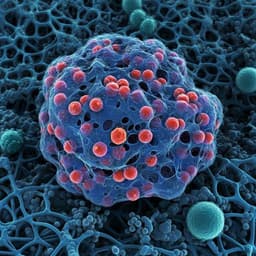
Engineering and Technology
Nanoparticle meta-grid for enhanced light extraction from light-emitting devices
D. Sikdar, J. B. Pendry, et al.
Discover a groundbreaking method that enhances light extraction from LEDs using a meta-grid of plasmonic nanoparticles, achieving up to 99% transmission efficiency. This exciting research conducted by Debabrata Sikdar, John B. Pendry, and Alexei A. Kornyshev not only boosts energy efficiency but also extends the lifespan of LEDs.
~3 min • Beginner • English
Introduction
The study addresses the long-standing challenge of limited light extraction efficiency in conventional semiconductor LEDs caused by (i) critical-angle restrictions at the high-index chip to low-index encapsulant interface, and (ii) Fresnel reflection losses even within the escape cone. Traditional remedies—such as high-index encapsulants, hemispherical chip geometries, graded-index coatings, microlens arrays, or increasing the effective index of the encapsulant with nanoparticle fillers—face manufacturability, transparency, bulkiness, or other trade-offs. The authors propose a minimally invasive modification: a metasurface-like monolayer (“meta-grid”) of subwavelength plasmonic nanoparticles placed within the standard encapsulant, above the chip surface. By tailoring nanoparticle material, size, spacing, and height above the interface, they aim to engineer destructive interference between reflections from the chip/encapsulant interface and the NP layer, thereby reducing Fresnel reflection and enhancing transmission within the escape cone. The work explores the theoretical basis, design rules, and performance potential of this approach.
Literature Review
The paper reviews approaches to improve LED extraction efficiency: (1) high-index encapsulants (e.g., chalcogenide glasses) to reduce index contrast, which face fabrication and transparency challenges; (2) hemispherical chip shapes to avoid total internal reflection, which are bulky and uneconomical; (3) graded-index coatings and microlens arrays (e.g., SiO2/PS) to reduce Fresnel loss and expand the escape cone; and (4) increasing the effective refractive index of packaging via nanoparticle-loaded epoxies or engineered resins. The latter needs precise control of particle density and dispersion to maintain transparency and avoid agglomeration, and can increase reflection at the encapsulant/air interface. These limitations motivate the alternative proposed: a discrete NP meta-grid designed for interference-based reflection cancellation without bulk material changes.
Methodology
- Device concept: Insert a monolayer meta-grid of subwavelength metallic nanoparticles (hexagonally packed nanospheres) in the encapsulant, at height h above the LED chip/encapsulant interface. The meta-grid is optimized to destructively interfere with the Fresnel-reflected wave from the interface, boosting transmission through the interface within the escape cone.
- Optical model: A four-layer stack is modeled with the NP array represented by an effective thin film of thickness d derived from effective medium theory. Transmission is computed with an internal source (emitter) in the chip (n1) and detector in the encapsulant (n2), capturing the chip-to-encapsulant transmission relevant to extraction. Silver permittivity is taken from literature. The meta-grid is assumed hexagonal for higher packing density and stronger collective plasmonic response. The baseline case without NP layer is used for comparison.
- Parameters and sweeps: Systematically varied nanoparticle radius R, interparticle gap g (center-to-center spacing set by hexagonal lattice), and height h. Typical ranges: R ~ 5–50 nm, g ~ 1–250 nm, h ~ 0–500 nm (1 nm steps for optimization). Spectral analyses over 400–1000 nm and specific optimization at a target LED emission (e.g., red LED, 625 nm) were performed. Both normal incidence and off-normal angles (s and p polarizations) up to the critical angle were analyzed.
- Physics interpretation: The NP array exhibits a collective localized plasmon resonance manifested as an extinction peak (absorption + scattering), appearing as a dip in transmission. The position and width of this dip depend on R, g, and h. Transmission enhancement is realized on the long-wavelength side of this dip via Fabry–Perot-like interference between reflections from the chip/encapsulant interface and from the NP meta-grid. The optimal h follows a resonance condition periodic in h by lambda/(4 n2).
- Validation: Analytical model (effective medium + multilayer transfer) is cross-validated with full-wave electromagnetic simulations, showing close correspondence in transmission spectra around the resonance region.
- Material choice: Silver nanospheres are used as a representative plasmonic resonator with relatively low loss and strong plasmonic response.
Key Findings
- Baseline Fresnel loss: For a typical interface with n1=3.5 (chip) and n2=1.6 (encapsulant), only ~84% of normally incident light transmits into the encapsulant without the NP layer.
- Transmission boost: With an optimized NP meta-grid, transmission at the peak emission wavelength can be raised to approximately 99% (near-complete cancellation of interface reflection).
- Parameter trends (spectral behavior):
- Reducing interparticle gap g strengthens coupling, red-shifting and broadening the extinction peak, which can lower average transmission if the dip overlaps the emission band.
- Increasing height h (keeping composition fixed) does not significantly shift the extinction peak but broadens it due to reduced image-charge interactions.
- Increasing NP radius R (fixed g, h) blue-shifts, narrows, and weakens the extinction dip (due to reduced image-charge interactions), but excessive R increases absorption, diminishing benefits.
- Fabry–Perot mechanism: Optimal heights repeat with period h + m·λ/(4 n2), confirming a cavity effect between the chip/encapsulant interface and the NP meta-grid. Placing the grid as close as practical to the interface is advised to limit lateral leakage.
- Case study (red LED): For AlGaInP (n1=3.49) with epoxy (n2=1.58) at λ=625 nm, optimization over h∈[0,500] nm, R∈[5,50] nm, g∈[1,250] nm yields multiple high-transmission solutions (T≥98.5%). Illustrative optimal sets include: (1) h≈185 nm, R=50 nm, g=150 nm; (2) h≈200 nm, R=35 nm, g=80 nm; (3) h≈216 nm, R=20 nm, g=30 nm. Angular analyses show improved transmission for s-, p-, and unpolarized light across permissible incident angles compared to no NP layer.
- Generality: The approach can be tuned for different LED emission spectra by selecting NP material and lattice parameters to position the extinction dip outside the emission band and exploit the steep transmission rise and long-wavelength tail.
Discussion
The work directly targets the Fresnel reflection component of extraction loss within the escape cone by engineering destructive interference using a nanoparticle meta-grid. This reduces the effective reflectance at the chip/encapsulant interface without altering the bulk encapsulant or chip geometry, thereby enhancing the fraction of generated photons that enter the encapsulant. The Fabry–Perot interpretation clarifies design rules: select R and g to place the extinction dip outside the LED band and choose h to satisfy the cavity phase condition λ/(4n2) periodicity for destructive interference of reflections. The improvements are robust across incident angles below the critical angle and can be tailored for different LEDs by parameter optimization. Practical implications include higher luminous efficacy and lower chip heating (due to reduced back-reflection), potentially extending device lifetime. The scheme can be integrated alongside other methods aimed at increasing the escape cone (e.g., surface texturing or microlenses) since it addresses a complementary loss mechanism.
Conclusion
The paper introduces a minimally invasive, theoretically guided strategy to enhance LED light extraction by embedding a monolayer meta-grid of plasmonic nanoparticles in the encapsulant above the chip. By optimizing nanoparticle size, spacing, and placement height, destructive interference between reflections from the interface and the NP layer suppresses Fresnel losses, boosting transmission at the emission wavelength from ~84% to as high as ~99% in representative cases. The analytical multilayer-effective-medium model agrees well with full-wave simulations and provides practical design rules, including the periodic height condition from Fabry–Perot cavity behavior. The approach is broadly tunable across spectra and compatible with existing packaging, and can be combined with methods that mitigate critical-angle losses. Potential future work includes experimental realization and manufacturing optimization (bottom-up self-assembly or top-down patterning), exploration of alternative NP materials and geometries for reduced absorption and broader bandwidth, and co-design with other extraction-enhancing techniques.
Limitations
- The enhancement addresses Fresnel reflection within the escape cone; it does not by itself expand the escape cone or eliminate total internal reflection.
- Performance is sensitive to precise NP parameters (R, g) and placement height h; misalignment of the extinction dip with the LED emission can reduce average transmittance.
- Plasmonic absorption imposes a trade-off, especially for larger nanoparticles or suboptimal arrays, potentially attenuating transmitted light.
- The model assumes an ideal hexagonal monolayer and uniformity; practical fabrication may introduce disorder, polydispersity, or deviations in h that can broaden resonances and reduce enhancement.
- Long-term material stability and compatibility with device processing are not addressed in the provided text.
Related Publications
Explore these studies to deepen your understanding of the subject.







